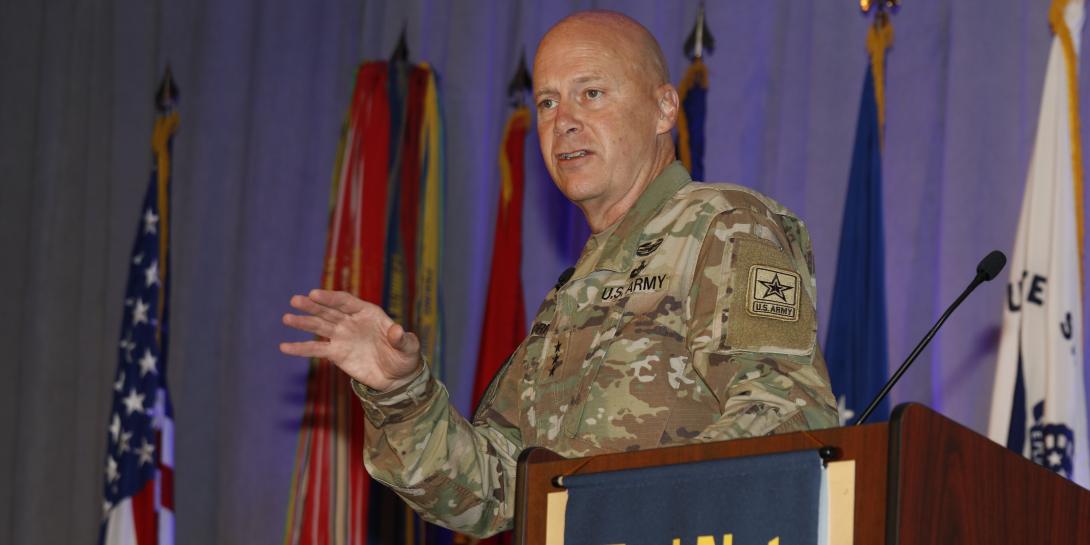Army Finalizing Unified Network Plans
The U.S. is in the final stages of developing its unified network plans, according to Lt. Gen. John Morrison, USA, deputy chief of staff, G-6.
Gen. Morrison made the comments on the first day of the 2021 AFCEA TechNet Augusta conference in Augusta, Georgia, the organization’s first in-person conference since the coronavirus pandemic.
“The Army unified network plan is in the final throes of staffing. It has gone through my level,” the general reported. “It’s going to be making its way up to the front offices with a detailed implementation plan that’s going to be codified in the next order because we’re going to treat this like an operation, and we’re going to pin very specific timelines and hold ourselves accountable.”
Lt. Gen. John Morrison, USA, deputy chief of staff, G6, says multi-domain operations will not happen without a Unified Network.#AFCEATechNet
— George Seffers (pronounced See furs) (@gseffers) August 17, 2021
With the help of the Network Cross-Functional Team (CFT), the service has come a long way in modernizing its tactical network, Gen. Morrison indicated. But work remains to be done. “The Network CFT has done tremendous things getting the tactical network on track, but it’s still very brigade combat team-focused,” he said.
The unified network will enable multidomain operations and has to start with optimizing the current network. “We just spent a lot of money on network modernization, operations, maintenance and security. I will submit to you we have not been near as efficient with those investments as we needed to, and therefore, we’ve made ourselves less effective,” Gen. Morrison declared. “But by aligning our investments and optimizing the network that we have, we can make a lot of progress.”
Unifying the network means aligning both tactical and enterprise modernization efforts, including networks for multiple security levels, he added.
He also asserted that technology is not the biggest challenge for Army modernization. “The technical piece of this is relatively straightforward. The people piece and getting that organization design component of it is really the toughest and the most important piece of it,” he said.
While the service’s enhanced Expeditionary Signal Battalions were a start, they were not the final answer. “When we did the Expeditionary Signal Battalion-Enhanced a couple of years ago, everybody thought that was the big idea. It wasn’t. It was really to reinvest those people in that DODIN [Department of Defense Information Network] ops framework globally,” he said.
He described a ripple effect of sorts that would lead to the reinforcement of the regional cyber centers and the transformation of theater tactical, corps and strategic signal brigades. “I can only tell you we probably got it about partially right. And we do have the folks moving. What we need to do now based on operations over the last three or four years is go back and revisit that.”
Army officials are working closely with the other services and the Joint Staff on the unified network concept, he noted. The Army and Air Force chiefs of staff have signed agreements regarding a path forward for unified networking and has pushed those ideas up to the Joint Staff.
LTG John Morrison, USA, deputy chief of staff, G6: Says we will see in coming years a shift in Army investments toward optimizing the network and divesting of capabilities no longer needed.#AFCEATechNet
— George Seffers (pronounced See furs) (@gseffers) August 17, 2021
Adm. Michael Gilday, USN, chief of naval operations, also has joined the discussion. “So, now we’re getting that broader coalition going, but again, the Joint Staff is in the room with us as we’re actually building out capabilities like the Joint Systems Integration Lab up at [Aberdeen Proving Ground], which is designed specifically to link all the service battle labs together so that we are informing ourselves,” he said. “The end state … is going to be the data standards that allow us to really drive interoperability across the joint force.”
The intelligence community also is critical to the discussions because intelligence underpins signal, cyber and electronic warfare missions. But the Army also is taking “significant steps” to ensure it protects sensitive modernization information from foreign intelligence operations. “We are putting the right controls in place to protect our modernization and make sure that we are not tipping everything that we are trying to accomplish to our adversaries,” the general noted.
LTG John Morrison, USA, deputy chief of staff, G6, says We are putting the proper protections in place for our modernization to ensure we do not tip our hands to our adversaries.#AFCEATechNet
— George Seffers (pronounced See furs) (@gseffers) August 17, 2021
The service also will continue experimenting with the Multi-Domain Task Force, which will be exploring tactical cloud computing capabilities. “We’ve done some, I would say at this point, some initial experimentation and demonstration with cloud computing being pushed into tactical formations,” Gen. Morrison offered. “We had a senior leader decision the other day that we are going to anchor our cloud … experimentation and demonstration in [20]22 and [20]23 to the Multi-Domain Task Force, tie it back into the enterprise efforts that are being led by the Unified Cloud Management activity, and then drive that pretty ruthlessly down into corps and divisions.”
In a series of meetings this week, service leaders will begin to hash out detailed plans for 2022 and 2023 “so we can anchor it to the investments we’ve already made in the Multi-Domain Task Force” and then “tie that back into our enterprise efforts…and drive that down into our tactical maneuver formations,” he reported. “So, you’re going to be seeing a lot more of that starting play out because the detailed planning is starting now.”





Comments